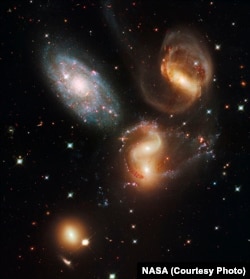The Hubble Space Telescope has been dazzling earthlings with views of deep space for over 26 years. That’s old for a satellite but NASA has a team of approximately 80 engineers working at the Goddard Space Flight Center in Greenbelt, Maryland to extend the life of Hubble’s mechanical parts.
Anticipating Anomalies
Hubble is taking pictures and transmitting them down to Earth 24 hours a day, 365 days a year, as it races around our planet at more than 27,000 kilometers per hour. This means that most of the instructions sent to the orbiting observatory must be automated and uploaded ahead of time.
So, the engineers at Goddard spend much of their time coming up with innovative ways to keep the decades-old mechanisms on Hubble moving. This usually involves minimizing the motions of the most-used gears and predicting the future. “Part of our jobs here at Goddard is to try to anticipate problems ... and try to find ways to work around them or respond to them so we get back to science” as quickly as possible, Olivia Lupie, mission operations manager for Hubble, tells VOA.
Months and months pass between issues. But rest assured, the engineers are prepared to respond to get the telescope back on its science schedule -- even on weekends.
Hubble Tetris
Astronomers from around the world request images from Hubble. Each week, Merle Reinhart, an engineer at the Space Telescope Science Institute, is tasked with organizing hundreds those requests. “It’s kind of a big jigsaw puzzle. The hard part is trying to figure out the most efficient way to put all those together so that we’re making maximum use of the time on Hubble,” Reinhart explains. “We really don’t want the spacecraft sitting there doing nothing.”
The images are usually available within 24-48 hours. It can take anywhere from a few weeks to a few months for the researchers to look at the data and tell the world about their exciting results.
Data from Hubble has allowed astronomers to make cosmic breakthroughs:
- pin down the age of the universe by measuring the brightness of stars in distant galaxies
- watch comets plunge into Jupiter’s clouds, providing new insights into the physics of the stormy planet
- take the very first images of planet-forming disks around newborn stars, something astronomers knew had to be there but never dreamed they’d see with their own eyes
Cosmic team-up
NASA began constructing Hubble in 1979 for what was planned as a 15-year mission. But several visits by shuttle astronauts to fix problems and install updates prolonged its life beyond that, and Hubble is still working so well that NASA just extended its operation for another five years. That means its mission will overlap with the James Webb Space Telescope (JWST), scheduled to launch in October, 2018. That will give astronomers what Malcolm Niedner, JWST project manager, calls "a very full toolkit." "Hubble is primarily an optical and ultra-violet telescope," he explained. "James Webb is an infrared telescope. Having them both together, very potent, very powerful."
The James Webb Space Telescope is still being assembled and tested here on Earth but astronomers can hardly wait to see what this dynamic duo can produce.












